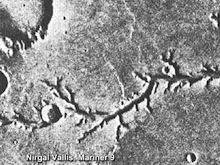Water on Mars has a long history
TheGuardian: Curiosity's discovery of a dry river bed adds to a 40-year-old body of evidence for once-flowing water on Mars
It was November 1971. The scene at Nasa was a tense one, similar to that of Curiosity's landing back in August. Ground controllers held their collective breath as Mariner 9 approached Mars. If everything went to plan, the spacecraft would make history by being the first manmade object to go into orbit around Earth's neighbouring planet.
Mariner 9 was an octagonal spacecraft just less than a metre and a half across, with four cross-like solar panels sticking out another two metres from its body. Its mission was to map Mars. At the appointed time, the retrorockets fired and Mars' gravity took hold of the spacecraft.
Soon afterwards, data began to flow back to Earth from the cameras. Images built up on the monitor screens line by line but the scientists stared in mounting disappointment. Nothing was visible. The whole planet was engulfed in a dust storm. All the exquisite geology that the spacecraft was meant to see lay buried under a blanket of suspended particles.
All the personnel could do was wait for the dust to settle, and pray that the spacecraft would wait too. Even today spacecraft can be fickle things. Back then, they were positively cranky. They could fail at any time, for any of a thousand different unanticipated reasons. Mariner 8, for example, had been destroyed during its launch.
Time was of the essence as the dust storm raged. Days turned to weeks until the Martian skies finally began to clear in January. As it did, one titanic mountainous peak after another broke through the murk. These were the extinct volcanoes of the Tharsis region.
 In 1972, Mariner 9 returned the first images of dry rivers on Mars. This is Nirgal Vallis in the Red Planet's southern hemisphere. Photograph: NASA/JPL-Caltech.
In 1972, Mariner 9 returned the first images of dry rivers on Mars. This is Nirgal Vallis in the Red Planet's southern hemisphere. Photograph: NASA/JPL-Caltech.
As the dust dropped out of the atmosphere, so the geology of Mars revealed itself: canyons and valleys, craters and plateaux. TheMariner rift valley was named after this spacecraft. And then there were the meandering channels. These were the real prize. Unmistakable to geologists, they were dried-up rivers. Water had once flowed on Mars.
It is now 40 years since that first observational proof was beamed back to Earth. Every Mars mission since has corroborated the finding and yet new evidence for rivers or lakes still excites us more than anything else. The only news that could trump it would be the discovery of life on Mars.
Friday's announcement that Nasa's Curiosity rover was driving across adry river bed allows us to imagine a time in the past when there was another blue planet in the solar system.
The finding itself is not a surprise. From orbit, the landing region displayed an 'alluvial fan', which is similar to a river delta, where river-borne sediments are deposited. Instead, the excitement is because Curiosity can deliver the ground truth. According to Nasa, the sizes and shapes of stones offer clues to the speed and distance of a long-ago stream's flow. This is information that is impossible to estimate with any accuracy from orbital pictures.
So Curiosity continues the grand tradition begun by Mariner 9 of detailing the evidence for Mars' past water. As its mission continues it may also see something else that Mariner 9 did: a dust storm.
Martian dust storms are most likely to take place when the planet approaches the Sun. This will happen next in January 2013. At that time, the planet will receive almost 50% more energy from the Sun than when it is at its furthest point. Even now, the warmth and light are building.
This extra heating melts the carbon dioxide ice from the polar caps to create a thicker, higher pressure atmosphere. As the gas tears around the planet, it can lift dust into the atmosphere and blanket the globe.
Early results from Curiosity's 'weather station' instruments suggest that the pressure in the Martian atmosphere could already be rising faster than expected. The trouble is that no one understands the Martian atmosphere well enough to know whether this makes a storm more or less likely.
If one does blow up, Curiosity is guaranteed a good view. Unlike Mariner 9, however, Nasa's latest Martian explorer will not be looking down from orbit, it will be right in the thick of it.
Stuart Clark is the author of The Sky's Dark Labyrinth trilogy (Polygon).
